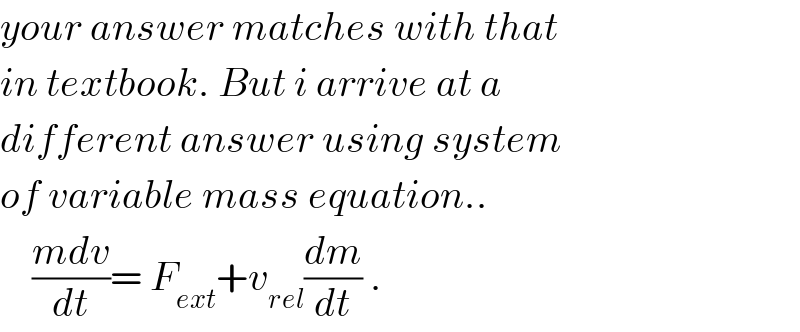Question Number 26047 by ajfour last updated on 18/Dec/17

Commented by ajfour last updated on 18/Dec/17

$${Initially}\:{a}\:{chain}\:{lies}\:{on}\:{a} \\ $$$${frictionless}\:{table}\:{top}\:{with}\:{length} \\ $$$$\boldsymbol{{h}}\:{hanging}\:{such}\:{that}\:{end}\:{B}\:{touches} \\ $$$${the}\:{ground}.\:{If}\:{released},\:{with}\:{what} \\ $$$${speed}\:{does}\:{end}\:{A}\:{slip}\:{of}\:{the}\:{table} \\ $$$${corner}?\:\left({Assume}\:{chain}\:{remains}\right. \\ $$$$\:{in}\:{three}\:{sections}-{a}\:{horizontal} \\ $$$${section}\:{on}\:{table},\:{a}\:{vertical}\:{section} \\ $$$${by}\:{the}\:{vertical}\:{side}\:{of}\:{table},\:{and} \\ $$$${a}\:{section}\:{as}\:{heap}\:{deposited}\:{on} \\ $$$${ground}\:{in}\:{between}\:{initial}\:{to} \\ $$$$\left.{final}\:{situation}\right). \\ $$
Commented by ajfour last updated on 19/Dec/17

$${your}\:{answer}\:{matches}\:{with}\:{that} \\ $$$${in}\:{textbook}.\:{But}\:{i}\:{arrive}\:{at}\:{a} \\ $$$${different}\:{answer}\:{using}\:{system} \\ $$$${of}\:{variable}\:{mass}\:{equation}.. \\ $$$$\:\:\:\:\frac{{mdv}}{{dt}}=\:{F}_{{ext}} +{v}_{{rel}} \frac{{dm}}{{dt}}\:. \\ $$
Commented by mrW1 last updated on 19/Dec/17

$${Can}\:{you}\:{post}\:{your}\:{solution}\:{please}? \\ $$$${I}\:{am}\:{not}\:{familiar}\:{with}\:{motion}\:{of} \\ $$$${variable}\:{mass}. \\ $$
Commented by ajfour last updated on 19/Dec/17

Commented by ajfour last updated on 19/Dec/17
![For the system in blue boundary: mass = m_B =((m_0 h)/l) =constant (as much mass goes in comes out) so simply ((m_0 gh)/l)−T=(((m_0 h)/l))a ..(i) For system in red boundary mass is variable (the mass that leaves the blue boundary system = mass that leaves the red boundary system at zero relative velocity to the system mass) And m_R =((m_0 (l−h−x))/l) so the term v_(rel) (dm_R /dt) =0 as v_(rel) =0 because it should be noted that the leaving mass arrives to zero speed by impact of ground only after it leaves the blue boundary at speed v (the velocity of moving part of chain). so for mass m_R : T=((m_0 (l−h−x)a)/l) adding eq. (i) to this gives ((m_0 gh)/l)=((m_0 (l−x)a)/l) or a=((vdv)/dx)=((gh)/(l−x)) ⇒ ∫_0 ^( v) vdv =gh∫_0 ^( l−h) (dx/(l−x)) ⇒ (v^2 /2)= ghln [(l/(l−(l−h)))] ⇒ v^2 =2ghln (l/h) , or v=(√(2ghln ((l/h)))) .](https://www.tinkutara.com/question/Q26093.png)
$${For}\:{the}\:{system}\:{in}\:{blue}\:{boundary}: \\ $$$${mass}\:=\:{m}_{{B}} =\frac{{m}_{\mathrm{0}} \boldsymbol{{h}}}{\boldsymbol{{l}}}\:\:={constant} \\ $$$$\left({as}\:{much}\:{mass}\:{goes}\:{in}\:{comes}\:{out}\right) \\ $$$${so}\:{simply}\:\:\:\frac{{m}_{\mathrm{0}} {gh}}{{l}}−{T}=\left(\frac{{m}_{\mathrm{0}} {h}}{{l}}\right){a}\:\:\:..\left({i}\right) \\ $$$${For}\:{system}\:{in}\:{red}\:{boundary} \\ $$$${mass}\:{is}\:{variable}\:\left({the}\:{mass}\:{that}\right. \\ $$$${leaves}\:{the}\:{blue}\:{boundary}\:{system} \\ $$$$=\:{mass}\:{that}\:{leaves}\:{the}\:{red} \\ $$$${boundary}\:{system}\:{at}\:{zero}\:{relative} \\ $$$$\left.{velocity}\:{to}\:{the}\:{system}\:{mass}\right) \\ $$$${And}\:\:{m}_{{R}} =\frac{{m}_{\mathrm{0}} \left({l}−{h}−{x}\right)}{{l}} \\ $$$$\:{so}\:{the}\:{term}\:\:{v}_{{rel}} \frac{{dm}_{{R}} }{{dt}}\:=\mathrm{0}\:\:{as} \\ $$$${v}_{{rel}} =\mathrm{0}\:\:{because} \\ $$$${it}\:{should}\:{be}\:{noted}\:{that}\:{the}\:{leaving} \\ $$$${mass}\:{arrives}\:{to}\:{zero}\:{speed}\:{by} \\ $$$${impact}\:{of}\:{ground}\:{only}\:{after}\:{it} \\ $$$${leaves}\:{the}\:{blue}\:{boundary}\:{at}\:{speed} \\ $$$${v}\:\left({the}\:{velocity}\:{of}\:{moving}\:{part}\:{of}\right. \\ $$$$\left.{chain}\right). \\ $$$${so}\:{for}\:{mass}\:{m}_{{R}} : \\ $$$$\:\:\:\:\:{T}=\frac{{m}_{\mathrm{0}} \left({l}−{h}−{x}\right){a}}{{l}} \\ $$$${adding}\:{eq}.\:\left({i}\right)\:{to}\:{this}\:{gives} \\ $$$$\frac{{m}_{\mathrm{0}} {gh}}{{l}}=\frac{{m}_{\mathrm{0}} \left({l}−{x}\right){a}}{{l}} \\ $$$${or}\:\:{a}=\frac{{vdv}}{{dx}}=\frac{{gh}}{{l}−{x}} \\ $$$$\Rightarrow\:\:\:\:\int_{\mathrm{0}} ^{\:\:{v}} {vdv}\:={gh}\int_{\mathrm{0}} ^{\:\:{l}−{h}} \frac{{dx}}{{l}−{x}} \\ $$$$\Rightarrow\:\:\:\:\frac{{v}^{\mathrm{2}} }{\mathrm{2}}=\:{gh}\mathrm{ln}\:\left[\frac{{l}}{{l}−\left({l}−{h}\right)}\right] \\ $$$$\Rightarrow\:\:\:{v}^{\mathrm{2}} =\mathrm{2}{gh}\mathrm{ln}\:\frac{{l}}{{h}}\:,\:\:{or} \\ $$$$\:\:\:\:\:\:\:\boldsymbol{{v}}=\sqrt{\mathrm{2}\boldsymbol{{gh}}\mathrm{ln}\:\left(\frac{\boldsymbol{{l}}}{\boldsymbol{{h}}}\right)}\:\:. \\ $$
Commented by ajfour last updated on 19/Dec/17

$${sorry}\:{sir},\:{i}\:{was}\:{mistaken};\:{as}\:{i} \\ $$$${consider}\:{two}\:{boundaries},\:{i}\:{arrive} \\ $$$${at}\:{the}\:{same}\:{answer}. \\ $$$${v}_{{rel}} =\mathrm{0}\:;\:{so}\:{the}\:{eq}.\:{is}\:{same}\:{as} \\ $$$${without}\:{variable}\:{mass}. \\ $$
Answered by mrW1 last updated on 18/Dec/17
![when a length of x lies on the ground, ρhg=(l−x)ρa ⇒a=((hg)/(l−x))=v(dv/dx) ⇒vdv=hg×(dx/(l−x)) ⇒∫_0 ^v vdv=hg×∫_0 ^x (dx/(l−x)) ⇒(v^2 /2)=hg[ln (l−x)]_x ^0 =hgln (l/(l−x)) ⇒v=(√(2hgln (l/(l−x)))) at x=l−h: ⇒v_1 =(√(2hgln (l/h)))](https://www.tinkutara.com/question/Q26063.png)
$${when}\:{a}\:{length}\:{of}\:{x}\:{lies}\:{on}\:{the}\:{ground}, \\ $$$$\rho{hg}=\left({l}−{x}\right)\rho{a} \\ $$$$\Rightarrow{a}=\frac{{hg}}{{l}−{x}}={v}\frac{{dv}}{{dx}} \\ $$$$\Rightarrow{vdv}={hg}×\frac{{dx}}{{l}−{x}} \\ $$$$\Rightarrow\int_{\mathrm{0}} ^{{v}} {vdv}={hg}×\int_{\mathrm{0}} ^{{x}} \frac{{dx}}{{l}−{x}} \\ $$$$\Rightarrow\frac{{v}^{\mathrm{2}} }{\mathrm{2}}={hg}\left[\mathrm{ln}\:\left({l}−{x}\right)\right]_{{x}} ^{\mathrm{0}} ={hg}\mathrm{ln}\:\frac{{l}}{{l}−{x}} \\ $$$$\Rightarrow{v}=\sqrt{\mathrm{2}{hg}\mathrm{ln}\:\frac{{l}}{{l}−{x}}} \\ $$$${at}\:{x}={l}−{h}: \\ $$$$\Rightarrow{v}_{\mathrm{1}} =\sqrt{\mathrm{2}{hg}\mathrm{ln}\:\frac{{l}}{{h}}} \\ $$
Answered by mrW1 last updated on 18/Dec/17
![With friction between chain and table: ρhg−μ(l−x−h)ρg=ρ(l−x)a (1+μ)h−μ(l−x)=(l−x)(a/g) a=(((1+μ)h−μ(l−x))/(l−x))×g=v(dv/dx) ((vdv)/g)=[(((1+μ)h)/(l−x))−μ]dx (v^2 /(2g))=(1+μ)hln (l/(l−x))−μx ⇒v=(√(2g[(1+μ)hln (l/(l−x))−μx])) ⇒v_1 =(√(2g[(1+μ)hln (l/h)−μ(l−h)]))](https://www.tinkutara.com/question/Q26064.png)
$${With}\:{friction}\:{between}\:{chain}\:{and}\:{table}: \\ $$$$\rho{hg}−\mu\left({l}−{x}−{h}\right)\rho{g}=\rho\left({l}−{x}\right){a} \\ $$$$\left(\mathrm{1}+\mu\right){h}−\mu\left({l}−{x}\right)=\left({l}−{x}\right)\frac{{a}}{{g}} \\ $$$${a}=\frac{\left(\mathrm{1}+\mu\right){h}−\mu\left({l}−{x}\right)}{{l}−{x}}×{g}={v}\frac{{dv}}{{dx}} \\ $$$$\frac{{vdv}}{{g}}=\left[\frac{\left(\mathrm{1}+\mu\right){h}}{{l}−{x}}−\mu\right]{dx} \\ $$$$\frac{{v}^{\mathrm{2}} }{\mathrm{2}{g}}=\left(\mathrm{1}+\mu\right){h}\mathrm{ln}\:\frac{{l}}{{l}−{x}}−\mu{x} \\ $$$$\Rightarrow{v}=\sqrt{\mathrm{2}{g}\left[\left(\mathrm{1}+\mu\right){h}\mathrm{ln}\:\frac{{l}}{{l}−{x}}−\mu{x}\right]} \\ $$$$\Rightarrow{v}_{\mathrm{1}} =\sqrt{\mathrm{2}{g}\left[\left(\mathrm{1}+\mu\right){h}\mathrm{ln}\:\frac{{l}}{{h}}−\mu\left({l}−{h}\right)\right]} \\ $$
